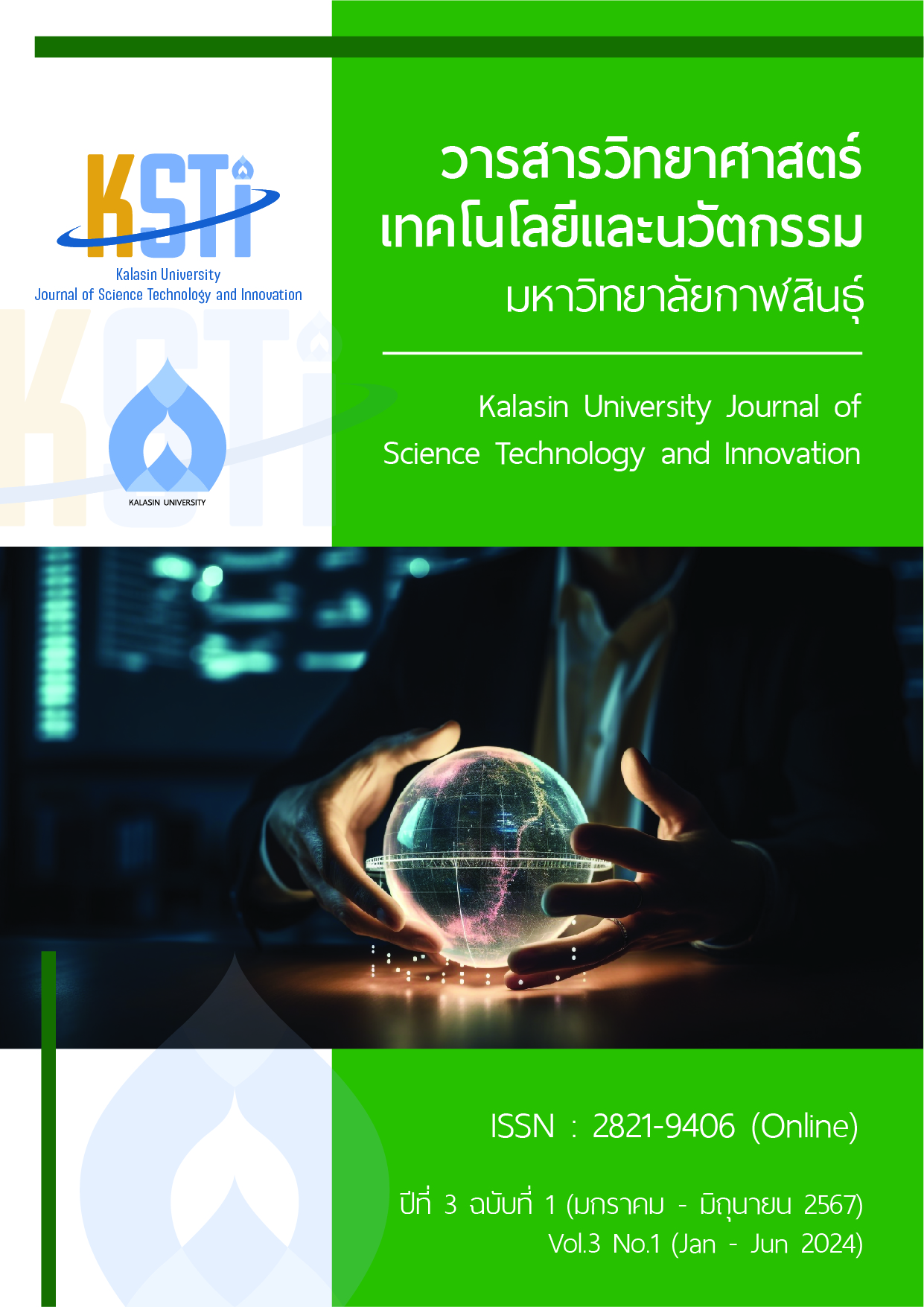Seasonal and Regional Dependence of Cloud-to-Ground Lightning Density and Return Stroke Peak Current over Thailand
Main Article Content
Abstract
Negative and Positive Cloud-to-Ground lightning flashes 67,921 events obtained by World Wide Lightning Location Network (WWLLN) between January 2017 and December 2019 were used to study the seasonal and regional dependence of CG flash density and return stroke peak current over Thailand. We found that the highest CG flash density occurs in eastern Thailand. The CG flash density over this area is higher than 50 flashes/square kilometers/year, especially between March and May, CG flash occurs 1.2 events every minute. However, over northern Thailand, the CG flash density is less than 5 flashes/square kilometers/year. It is also found that the return stroke peak current of CG lightning over Thailand varies from 10kA – 150kA with an average value of 61.1 kA.
Downloads
Article Details

This work is licensed under a Creative Commons Attribution-NonCommercial-NoDerivatives 4.0 International License.
The owner (Research and Development Institute, Kalasin University), the authors agree that any copies of the article or any part thereof distributed or posted by them in print or electronic format as permitted will include the notice of copyright as stipulated in the journal and a full citation to the final published version of the contribution in the journal as published by Research and Development Institute, Kalasin University.
References
Christian H, Blakeslee R, Boccippio D, Boeck W, Buechler D, Driscoll K, et al. Global frequency and distribution of lightning as observed from space by the optical transient detector. 2003; Journal of Geophysical Research. 108(1): 4-15. doi:10.1029/2002JD002347.
Sato M, Fukunishi H, Kikuchi M, Yamagishi H, Lyons W. Validation of sprite-inducing cloud-to-ground lightning based on elf observations at syowa station in antarctica. 2003; Journal of Atmospheric and Solar-Terrestrial Physics. 65(5): 607–614. doi:10.1016/S1364-6826(02)00327-9.
Bandholnopparat K, Sato M, Adachi T, Ushio T, Takahashi Y. Estimation of the IC to CG ratio using JEM-GLIMS and ground-based lightning network data. 2020; Journal of Geophysical Research: Atmospheres, 125(23): 1-14. doi:10.1029/2019JD032195.
Rycroft M, Israelsson S, Price C. The global atmospheric electric circuit, solar activity and climate change. 2000; Journal of Atmospheric and Solar-Terrestrial Physics. 62(17): 1563–1576. doi:10.1016/S13646826(00)00112-7.
Rycroft M, Odzimek A, Arnold N, Füllekrug M, Kulak A, Neubert T. New model simulations of the global atmospheric electric circuit driven by thunderstorms and electrified shower clouds: The roles of lightning and sprites. 2007; Journal of Atmospheric and Solar-terrestrial Physics. 69(17): 2485–2509. doi:10.1016/j.jastp.2007.09.004.
Williams E, Boldi B, Matlin A, Weber M, Hodanish S, Sharp D, et al. The behavior of total lightning activity in severe florida thunderstorms. 1999; Atmospheric Research, 51(34): 245-265. doi:265.10.1016/S01698095(99)00011-3.
Rakov V, Uman M, Raizer Y. Lightning: Physics and effects. 5th ed. New York, NY: Cambridge University Press, 2004.
Pickering E, Wang Y, Tao K, Price C, Müller F. Vertical distributions of lightning nox for use in regional and global chemical transport models. 1998; Journal of Geophysical Research. 1033(23): 203–216. doi:10.1029/98JD02651.
Ballarotti G, Saba F, Pinto O. High-speed camera observations of negative ground flashes on a millisecond-scale, 2005; Geophysical Research Letters, 32(23): 1-4. doi:10.1029/2005GL023889.
Adachi T, Sato M, Ushio T, Yamazaki A, Suzuki M, Kikuchi M, et al. Identifying the occurrence of lightning and transient luminous events by nadir spectrophotometric observation. 2016; Journal of Atmospheric and Solar-Terrestrial Physics. 145(1): 85–97. doi:10.1016/j.jastp.2016.04.010.
Cummins K, Cramer J, Biagi C, Krider E, Jerauld J, Uman M, et al. The U.S. national lightning detection network: Post-upgrade status: In: 86th AMS Annual Meeting, 2006 Jan 27; Atlanta.
Dowden R, Brundell J, Rodger C. Vlf lightning location by time of group arrival (toga) at multiple sites. 2002; Journal of Atmospheric and Solar- Terrestrial Physics. 64(7):817–830. doi:10.1016/S1364-6826(02)00085-8.
Hutchins L, Holzworth H, Brundell B, Rodger J. Relative detection efficiency of the World Wide Lightning Location Network. 2012; Radio Sci. 47(6): 1-9. doi:10.1029/2012RS005049.
López A, Montanyà J, Van Der Velde O, Romero D, Aranguren H, Torres H, et al. First data of the colombia lightning mapping array - colma. 2016; Proceeding of the 33rd International Conference on Lightning Protection, 2016 October 16-21; Estoril.
Boccippio D, Cummins K, Christian H, Goodman S. Combined satellite and surface-based estimation of the intracloud/ cloud-to-ground lightning ratio over the continental united states. 1999; Monthly Weather Review, 129(1): 108-122. doi:10.1175/1520-0493(2001)129<0108:CSASBE>2.0.CO;2.
Cecil J, Buechler D, Blakeslee R. Gridded lightning climatology from trmm-lis and otd: dataset description. 2013; Atmospheric Research, 135(1): 404-414. dooi:10.1016/j.atmosres.2012.06.028.
Buechler D, Driscoll K, Goodman S, Christian H. Lightning activity within a tornadic thunderstorm observed by the optical transient detector (otd). 2000; Geophysical Research Letters. 27(15): 2253-2256. doi:10.1029/2000GL011579.
Koshak J. Optical characteristics of otd flashes and the implications for flash-type discrimination. 2010; Journal of Atmospheric and Oceanic Technology. 27(11): 1822–1838. doi: 10.1175/2010JTECHA1405.1.
Blakeslee R, Mach D, Bateman M, Bailey J, Seasonal variations in the lightning diurnal cycle and implications for the global electric circuit. 2014; Atmospheric Research, (135–136): 228-243. doi.org/10.1016/j.atmosres.2012.09.023.
Sato M, Fukunishi H, Kikuchi M, Yamagishi H, Lyons W. Validation of sprite-inducing cloud-to-ground lightning based on elf observations at syowa station in antarctica. 2003; Journal of Atmospheric and Solar-Terrestrial Physics. 65(5): 607–614. doi:10.1016/S1364-6826(02)00327-9.
Rodger C, Brundell J, Holzworth R, Lay E. Growing detection efficiency of the world wide lightning location network. 2009; AIP Conference Proceedings. 47(6): 1-9 .doi:10.1063/1.3137706.
Abarca S, Corbosiero K, Galarneau T. An evaluation of the world wide lightning location network (wwlln) using the national lightning detection network (nldn) as ground truth. 2010; Journal of Geophysical Research. 115(18): 1-11. doi:10.1029/2009JD013411.
Nag A, Mallick S, Rakov V, Howard J, Biagi C, Hill J, et al. Evaluation of u.s. national lightning detection network performance characteristics using rocket-triggered lightning data acquired in 2004–2009. 2011; Journal of Geophysical Research, 116(2): 1-8. doi:10.1029/2010JD014929.
Stolzenburg M, Rust W, Marshall T. Electrical structure in thunderstorm convective regions 2. isolated storms. 1998; Journal of Geophysical Research. 103(12):14079–14096. doi:10.1029/97JD03546.
Stolzenburg M, Rust W, Marshall T. Electrical structure in thunderstorm convective regions 3. synthesis. 1998; Journal of Geophysical Research, 103(12):14097–14108. doi:10.1029/97JD03547.
Stolzenburg M, Rust W, Smull B, Marshall T. Electrical structure in thunderstorm convective regions mesoscale convective systems. 1998; Journal of Geophysical Research, 1031(12): 14059–14078. doi:10.1029/97JD03545.


